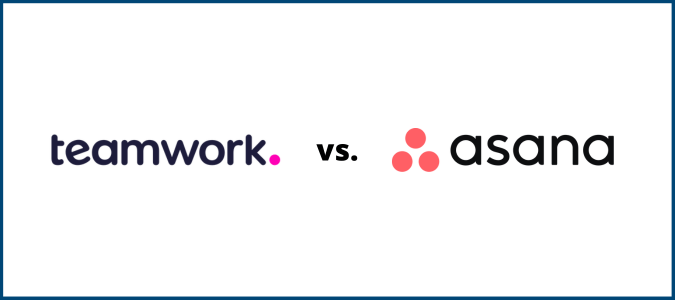Nintex is an industry-leading solution for workflow automation and process management. It’s powerful, complex, great for automating just about any type of process, and typically used by large businesses. Amazon, LinkedIn, and Coca-Cola are just a few of this brand’s real-life users.
But, with its power comes a hefty price tag and a lengthy learning curve. If those drawbacks don’t deter you, it’s an amazing piece of software that can turn your business into a well-oiled machine that gets more done without hiring anyone new.

Nintex Compared to the Best Workflow Management Software
To see how Nintex stacks up in the marketplace, we tested a range of other software options in the category of best workflow management software. Check out a few of our favorite alternatives below.
ProofHub is our top choice for workflow management, offering an excellent balance of ease of use, flexibility, and pricing. Try it free for 14 days.
Process Street is the way to go if you have simple needs and only need to manage a few distinct workflows. Sign up now and get two weeks free.
Hive is designed specifically for remote teams with project management features baked in. Explore its capabilities on a 14-day free trial.
Kintone is a smart choice if you need a lot of customization but have a small team and minimal budget. Try it free for 30 days, no credit card required.
If you want the most advanced, customizable, and flexible workflow and process automation software, Nintex is great for you. Keep reading to learn more about what it does well and where it falls flat.
Nintex: The Good and the Bad
Nintex is much more than an automation platform—it’s a modular low-code solution with multiple tools to help streamline processes and workflows across your business. In this section, we’ll examine what it does well and what makes it inaccessible for a lot of businesses.

What Nintex Is Good At
Like most workflow automation tools, Nintex can streamline how your team works. From standardizing processes and building complex workflows to automated document creation and custom mobile apps, it has a lot to offer.
But what makes it stand out (in a good way) from the rest? Let’s find out.
Automate just about anything: With Nintex, you can integrate your whole tech stack and automate processes or workflows across your entire business, even those that span multiple departments or several different tools. Other automation solutions have significant limitations or poor integration capabilities, but you’ll find neither with Nintex.
Need to automate the creation of work orders, invoices, contracts, or other documents? Leverage the software’s workflow builder. Maybe you have repetitive tasks like gathering feedback and routing it to the right person based on the topics involved. That can be put on auto-pilot, too. From the simplest to the most complex processes, Nintex handles it all.

Robotic process automation (RPA) capabilities: Nintex offers both attended and unattended RPA solutions that let you automate even the most complex computer-based tasks. With attended automations, users can keep an eye what’s happening and step in if needed. They can also use this feature to show new hires how to do everything they need to know—down to the smallest details, like where to click—and offering real-time guidance if they get stuck.
With unattended RPA, no oversight is needed and you get full, hands-off automation that does whatever you want it to. Both options leverage machine learning and world-class reading capabilities that let bots behave just like humans.
Drag-and-drop workflow tools: Nintex’s visual workflow designer lets you map out processes one step at a time without touching code. It’s as simple as clicking and dragging workflow elements, like approvals, decisions, branching logic, connectors, or notifications, and then watching your workflows spring to life. From new hire onboarding to daily reminders and managing requests, there are few limits to what you can build. And, whenever you’re ready, you can bring in a developer to take it to the next level—you don’t have to code on Nintex, but you can.

Logic templates: There are dozens of pre-built workflows you can tap into on Nintex, covering common scenarios from document approvals, reviews, and signatures to customer onboarding, loan applications, and invoice processing.
With just a few clicks, you can select a template and customize it to match how you work. No need to start from scratch—you get a ready-made framework that can simplify the setup of multiple automations and shorten your initial implementation time.
Connectors & open API: Pre-built connectors are drag-and-drop integrations you can use within the workflow builder to bring your tech stack together. Just drop a connector in the middle of a workflow to Office 365 to streamline document creation or insert a Slack connector to make sure notifications and alerts are always seen by the right team members.
You don’t have to spend hours tweaking settings—they work straight out of the box. However, you can customize these connectors further to really make your automations sing. If you can’t find a connector, you can use Nintex’s open API to unify your databases, cloud services, or other applications.

Process discovery: Are there actions your team participates in every day that you haven’t turned into a formal process? Maybe you have your process awareness down pat, but you don’t know which of these could potentially be automated. Nintex’s process discovery feature is essentially a bot that records normal activities, analyzes them, and lets you know how suitable they are for automation. It all happens behind the scenes as your team works, so there’s no disruption.
Over time, the bot maps the main path of each process—as well as every possible variation—and puts together documentation for you. You can then share it with your team, optimize it as needed, standardize it into a formal SOP, or automate it with Nintex’s process management tool.
Interdepartmental suitability: Specialized tools only work for one or two departments, but Nintex is flexible enough to manage workflows across every department, even processes that involve everyone. With premade templates for HR, IT, legal, customer support, and sales, you can bring the whole team into the loop without advanced customization. Then, tweak things one at a time until you’ve perfected it all. On top of departmental versatility, it’s also well suited for dozens of industries, including finance, government, manufacturing, and education to name a few.
What Nintex Is Lacking
Despite all of its virtues, Nintex isn’t without its drawbacks. After all, power and flexibility are usually inversely related to ease of use and cost. For the most part, Nintex might not be a great fit if you’re a small team with a limited budget.
Suitability for small businesses: Nintex’s robust feature set and incredible power make it overkill for a lot of organizations. With enterprise-grade functionality, it’s definitely better suited for large organizations with dedicated IT resources—not modest teams aiming to simplify a few workflows. For streamlining basic processes and automating a workflow or two, Nintex’s extensible platform isn’t necessary.
Plus, that power comes at a steep price, putting it out of reach for most small, growing, and midsize businesses. At a minimum of $15,000 per year (or $1,250 per month), Nintex simply isn’t feasible for a lot of budget-conscious companies. Unless you need the advanced power and customization of Nintex, you’ll likely find its price tag unjustifiable, especially compared to other tools that can help automate your workflows at a fraction of the cost.

Implementation: While Nintex can help you systematize and streamline even your most advanced processes, setting them all up in the software can take weeks or even months of planning and testing. You’ll need to carefully analyze how your teams work, determine rules, map out ideal processes, and build forms, workflow templates, and apps to support them. Once launched, you’ll go through rounds of feedback, adjustments, and re-training before you can truly let the automations run full scale.
For many companies, the long implementation is well worth the rewards of a sophisticated workflow engine that can handle nearly any challenge. But, if you’re looking for an out-of-the-box solution you can implement right away, Nintex isn’t it. Properly wielding its vast capabilities requires time and resources, a reality you should go into your buying decision fully aware of.
Learning curve: Nintex comes with a steep learning curve that requires patience, diligence, and time to master. Why? The interface is extensive, with many granular features and settings to explore. Even tech-savvy developers need time to learn how it all works together and how to fully master this platform.
On top of that, documentation is fragmented across various software versions, making it challenging to find the information you need. Troubleshooting problems or mistakes can feel like you’re piecing together clues from disparate sources. That’s incredibly frustrating if you’re new to Nintex or process management software in general.
Monthly plans: Nintex only offers annual contracts, which can compound the pain of its expensive price tag. Without a month-to-month billing option, you can’t test-drive Nintex for a few months to see if it’s the right solution for your needs with the freedom to deactivate your plan if it isn’t. You have to commit to an entire year up front, which means an outlay of tens of thousands of dollars. That is a huge cost to swallow for anyone, let alone if you end up not using it to its full potential.
There’s a 30-day free trial available by request, but that’s not always long enough to get deep enough in the platform to make any purchasing decisions. You also might be able to negotiate a shorter term contract to try it out, but that’s not publicly mentioned on their website.
Nintex Products and Pricing
Nintex offers a full suite of workflow, process, and automation tools, including bundled access to several solutions. The modular approach means you can choose which products will be the most impactful rather than having to pay for a bunch of capabilities you won’t use.
Below, we explore each product Nintex offers, including their benefits, who should use them, and the starting price point.
Automation Cloud
Nintex Workflow Automation Cloud is their core product, led by a drag-and-drop workflow builder that connects your tools and gets more done in less time.
The platform seamlessly integrates via premade connectors with popular applications like SharePoint, Office 365, Salesforce, and more. Automate document creation for repetitive records like contracts, invoices, and work orders, just to name one example. It also features an open API so you can automate processes across every business tool you use.
It also comes with templates for common workflows like employee onboarding, contract management, and expense approvals to get you up and running quickly, even if you don’t know how to code or program.
There are three different plans to choose from, all of which allow for unlimited users and workflows.
- Pro: starts at $25,000 per year and comes with 2,000 automated document runs
- Premium: starts at $50,000 per year and comes with 10,000 automated document runs
- Custom: personalized quote for whatever you need
If you need the ability to capture legally binding e-signatures or enhanced customer support for additional hands-on assistance, you can add either of those to any plan for an extra fee.
Automation Cloud, though costly, delivers increased efficiency, time savings, enhanced collaboration, improved compliance, and ultimate scalability. It’s a workflow automation tool you’ll never outgrow.

Process Discovery
Nintex Process Discovery provides a holistic view of your current processes so you can optimize resources, reduce inefficiencies, and plan for the future.
It works by automatically mapping your existing processes through data collected from various systems your teams already use every day. The bot designer makes it easy to set one up to watch your team work. The resulting visual process maps give you a bird’s-eye view of how work moves through your organization.
With them, you’ll be able to spot bottlenecks, redundancies, and areas where automation or process redesign could streamline operations. You and your team can collaborate directly within the platform to analyze processes, address problems, and implement changes that enhance productivity company-wide.
Integrated with the full Nintex platform, Process Discovery lets you seamlessly transition from discovering and mapping processes to actually optimizing and automating them with Automation Cloud.
There are three different tiers depending on the number of discovery bots you need—all three include unlimited users so you can invite your whole team regardless of the plan you choose.
- Pro: starts at $35,000 per year and includes three bots
- Premium: starts at $60,000 per year and comes with six bots
- Custom: fully personalized quote with as many bots as you need
Process Manager
Nintex Process Management is an advanced solution for mapping, optimizing, and managing business processes. It provides process owners, managers, and developers (plus the people who use those processes) full visibility into their workflows.
Map your current processes to understand dependencies and inefficiencies, while process dashboards provide performance stats to help you pinpoint areas for optimization. Integration with the broader Nintex platform allows you to quickly and easily put your process insights into action.
By maintaining a centralized repository of process maps and details, teams have a consistent reference point for training, onboarding, compliance, and risk management. Cross-functional teams can also collaborate more effectively to enhance and refine processes over time.
With role-based permission controls and process versioning, Nintex Process Management gives you confidence in the accuracy and security of your internal data. Teams can work together on refining workflows knowing their changes are tracked, managed, and only visible to authorized users.
There are two pricing tiers and a custom plan to choose from.
- Pro: starts at $20,000 per year and includes limited diagrams
- Premium: starts at $40,000 per year and includes 250 diagrams plus unlimited users
- Custom: personalized quote and can include unlimited diagrams
There are also a few add-ons that can increase the value of your plan, including a risk and compliance module, enhanced Nintex support, and white-glove services.

Robotic Process Automation (RPA)
Nintex offers attended and unattended robotic process automation (RPA) solutions to automate repetitive tasks at scale. Nintex’s drag-and-drop designer lets you build bots that take care of rules-based tasks for you, including work across multiple tools. Nintex bots can input data, extract information, complete forms, and execute approval workflows automatically on a set schedule or when triggered by specific events.
With the RPA platform, you can instantly populate customer records from web forms, process invoices as soon as they’re received, update and distribute reports company-wide every morning, and a whole lot more.
Plus, you’ll have an integrated view of all your bots and they work they do through detailed monitoring tools that measure metrics like time savings and ROI.
With attended RPA, bots works alongside your employees to assist with repetitive tasks. These bots are activated by specific user events or triggers, running on local machines to enable direct interaction and collaboration.
Attended RPA plans start at $20,000 per year with 50 bots, unlimited admins, and unlimited bot designers.
In contrast, unattended RPA bots operate independently around the clock to handle high-volume, rules-based workloads like data entry, report generation, and customer onboarding. Unattended bots are centrally managed for efficient scaling and human monitoring.
These plans are a bit cheaper, starting at $15,000 per year for two bots and unlimited users.

DocGen
DocGen is an advanced yet affordable document automation solution designed to help systematize the creation and distribution of documents.
While Nintex’s Automation Cloud has similar capabilities, DocGen is more narrow in scope. And it’s a more affordable alternative if you only need to automate document generation. It also supports unlimited documents, whereas Automation Cloud limits the number you can create.
Starting at just $2,400 per year ($200 per month), it’s about 10 times cheaper as well. You can also add eSign functionality to the standalone DocGen plan.
Put the creation of docs like sales proposals, contracts, and financial reports on auto-pilot. Plus, this platform seamlessly integrates with Salesforce so it can generate accurately fllled-out, personalized documents in seconds with no human input.
For example, it can generate a tailored sales proposal as soon as a new prospect is added to your CRM. Or, instantly create an offer letter customized with a new hire’s details as soon as they accept the position.
Nintex also provides centralized storage for generated documents so they’re all in one place—you never have to worry about storage or compliance.
If you’re looking to eliminate repetitive manual tasks, improve the accuracy of your documents, and optimize critical processes for sales, HR, or finance, DocGen is a great choice.

Process Platform (All-in-One)
If you need all of the above, you can bundle them together into one subscription. You can also customize the bundle by choosing the solutions you need.
Because it’s tailored to you, pricing is based on a custom quote.
Based on the combined entry-level price of each solution we talked about, the starting price is likely around $85,000 per year.
Comparing the Best Workflow Management Tools
As part of this review, we looked at numerous workflow management and automation tools. Our favorites include:
- ProofHub – Best for most
- Process Street – Best simple workflow management software
- Hive – Best workflow management software for remote teams
- Kintone – Best for custom workflows
- Nintex – Best for advanced workflows
- Zapier – Best for workflow automation
- Backlog – Best for developers
While Nintex isn’t our top choice, it’s a great option if you have a large budget and want to automate complex systems across your entire business. It’s not the easiest or the cheapest, but it is the most powerful.
Check out our full list of the best workflow management tools to learn more about our research process, including a full buyer’s guide to help you make the best decision.














